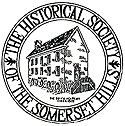Is Your House Historic?
Background and Purpose of the Guidelines
Like many who are trying to understand the differences between restoration, renovation, and reconstruction, the Historical Society of the Somerset Hills has helped many local residents research their homes to determine an appropriate restoration effort tied to the originating period.
These guidelines are endorsed by the Historical Society and are voluntary.
The Somerset Hills of New Jersey is home to many areas, sites, and structures that have shaped the identity of generations of citizens, collectively and individually, and have produced significant historic, architectural and cultural resources constituting our heritage. Many properties contribute to the historic nature of our community through their unique architectural, historical or geographic characteristics. The goal of the Somerset Hills Historical Society is to enhance and preserve historic structures as we seek to ensure the longevity of our community’s rich tradition.
The Historical Society promotes the guidelines below when considering a restoration, renovation, or alteration of historic buildings. These guidelines are intended to observe the rights of individual property owners with a respect for preserving our community’s architectural heritage. As such, the guidelines can inform interested homeowners and prospective buyers of relevant design issues prior to hiring a professional to rehabilitate or modify an historic property. Architects and other professionals may then use the guidelines -which include some general architectural principles on page 3 – during the design process. Further, these guidelines establish criteria the Historical Society will use when responding to any formal proposals submitted for consideration.
How do I know if I own a historic building?
Fifty years or older is a generally recognized guide for a building to be considered historic, but not all historic buildings are historically significant. The Historical Society has copies of the Somerset County cultural resource surveys for the five Somerset Hills towns. However, even if a building is not listed in a formal inventory, an owner of an older building may find the guidelines and principles helpful.
Criteria for considering a structure or site to be historically significant:
- Character, interest or value as part of the community’s development.
- Location was site of a significant historical event.
- The property is identified with people who made important contributions to political, social and/or cultural life of the community.
- The building embodies distinguishing characteristics of an architectural type.
- The building was designed by an architect, or constructed by a master builder or craftsman of local, regional, or national stature.
- The building embodies architectural design, detail, materials, or craftsmanship, which are significant. In some cases the architectural value may be due to the unique or innovative nature of the structure such as an expression of indigenous materials or techniques.
- The building may have a unique location that has become an established or familiar visual feature of the neighborhood or community.
- The property has symbolic meaning, value, or appeal to the community.
Download the complete guidelines Click Here
Rehabilitating Your Old House:
New Jersey’s Award-Winning Rehabilitation Subcode Imposing new building requirements on existing buildings creates a barrier to restoring historic buildings. Applying new building standards to these structures often disturbs the historic character of the building. Regulations that are specific and tailored to existing buildings can vastly facilitate and improve historic preservation efforts.
New Jersey’s Rehabilitation Subcode is an example of government reassessing its regulations and actually improving the effectiveness of the regulations by imposing fewer and more sensible requirements on the public. Building departments win because buildings are improved and made safer. Building owners win because they are able to improve their properties, increase their value, and produce buildings in which people want to live and work. Local construction officials have been trained to use the Subcode.
FOR ADDITIONAL INFORMATION
These guidelines acknowledge and are in support of the The Secretary of the Interior’s Standards for the Treatment of Historic Properties with Guidelines for Preserving, Rehabilitating, Restoring and Reconstructing Historic Buildings. Though the Standards are mandated for all historic structures officially recognized by Federal, State or local authorities, in many cases the Guidelines are also an excellent resource for those interested in working with any historic building. They provide information on all types of historic buildings whether commercial or residential and are not limited to types of construction, building sizes or levels of occupancy.
In summary, the Secretary’s Guidelines recognize four basic tenets when strictly adhering to the Standards of Historic Preservation: Identify, Protect, Repair and Replace. Available through the internet, the Standards and Guidelines are an excellent resource when considering the rehabilitation or alteration of any historic property. The National Park Service also has a number of additional resources available on the Internet, including a series of Preservation Brief that provide guidance on preserving, rehabilitating and restoring historic buildings.
Want to Research The History of Your Home?
The State of New Jersey has put together a great booklet for you to get started with your research.
Download Now Click Here
(We also have hard copies of this at the THSSH)
Don’t forget there is a wealth of information all around us.
- THSSH
- Local Libraries
- Local Tax Offices
- County Tax Offices (Somerville)
- State Offices
Trenton - Title Searchers
Class Program
Also, the Adult School of the Chathams, Madison, and Florham Park has created a new Special Interest Program held at the Morristown & Morris Township Library entitled, “Researching Your House’s History”
Click Here for more information.
If there’s something specific you are looking for, please don’t hesitate to drop us a note and let us know how your research is coming.



